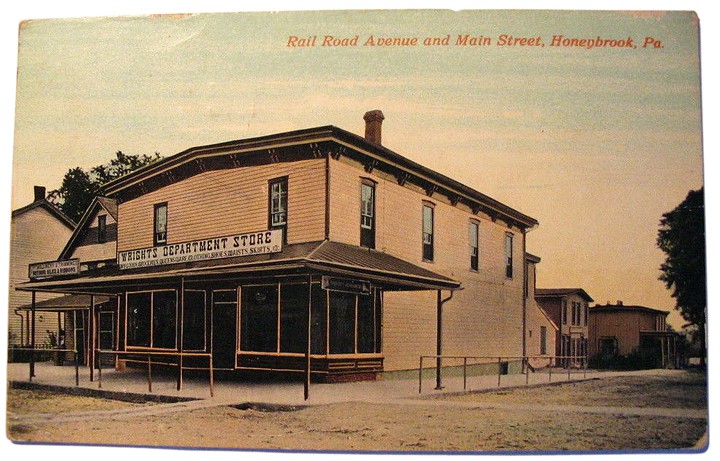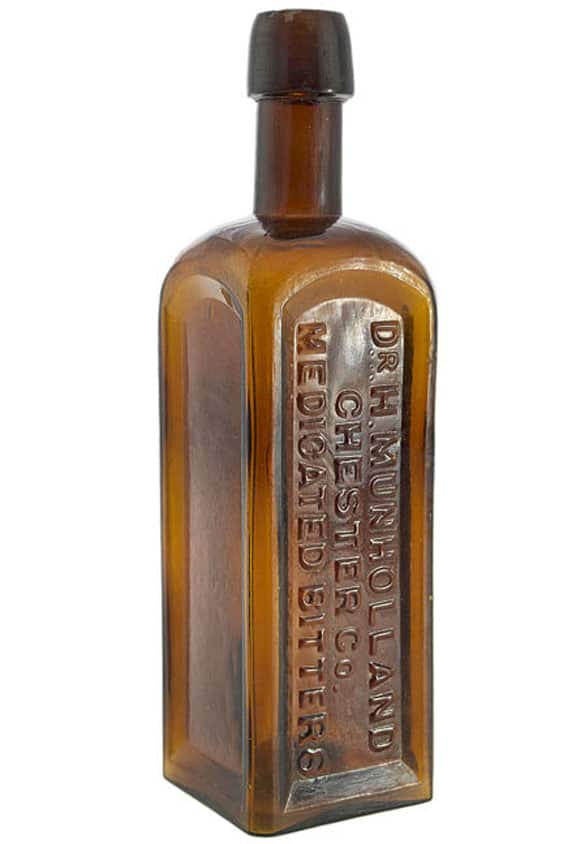 Dr. H. Munholland Medicated Bitters
Dr. H. Munholland Medicated Bitters
Chester County, Pennsylvania
27 November 2013
![]() The extremely rare, Dr. H. Munholland Medicated Bitters from Chester County, Pennsylvania is a tough one to find with an example showing up in Glass Works Auctions | Auction 100 that is currently on line. I also have an example that I need to photograph for this post. The Glass Works write-up for the bottle (pictured top of post) is as follows:
The extremely rare, Dr. H. Munholland Medicated Bitters from Chester County, Pennsylvania is a tough one to find with an example showing up in Glass Works Auctions | Auction 100 that is currently on line. I also have an example that I need to photograph for this post. The Glass Works write-up for the bottle (pictured top of post) is as follows:
Lot 174. “DR. H. MUNHOLLAND / CHESTER CO. / MEDICATED BITTERS”, (Ring/Ham, M-159.3), American, ca. 1875 – 1885, amber, 9”h, smooth base, applied mouth. A shallow 1/8” in diameter chip is off the outer edge of the lip, also some minor areas of removable stain. Extremely rare! Dr. Munholland was located in the town of Honey Brook in Chester County, Pennsylvania.
The Carlyn Ring and W. C. Ham listing in Bitters Bottles is as follows:
M 159.3 MUNHOLLAND MEDICATED BITTERS
DR. H. MUNHOLLAND / CHESTER CO. / MEDICATED BITTERS // sp // sp // sp //
9 x 2 1/2
Square, Amber, LTC, Applied mouth, 4 sp, Extremely rare
There are two dots under the R of DR, and the C in MEDICATED is closed like an O.
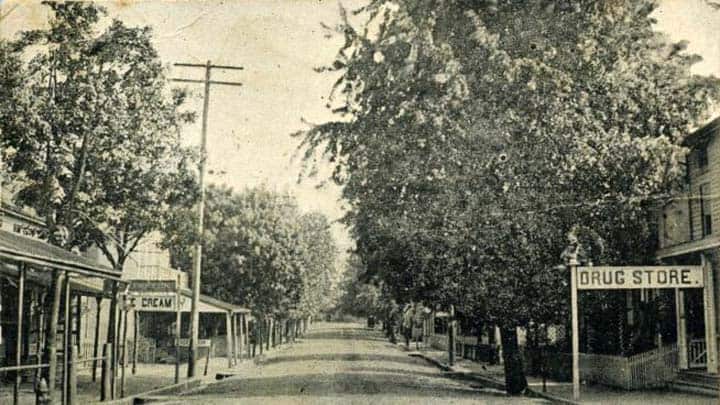
Drug Store on Main Street (looking east) in Waynesburg, Honey Brook Township, Chester County, Pennsylvania. This was most likely a Munholland business as the map further below shows Dr. Henry Munholland on Main Street.
We are talking here about Henry Munholland who was physician of considerable standing and practice who was born about 1808, probably in Chester County, Pennsylvania. Henry’s mother and father were both from Ireland. In 1836, Henry married Anna F. Lauer and they had three children including Henry Parker (b 1843), Margaretta, and Mary. Henry Parker Munholland was listed as a Allopathic Physician. The father and son doctors lived in Waynesburg, Honey Brook Township, Chester County, Pennsylvania. They were listed at two addresses at the same time as illustrated on the 1883 map below. One address on Main Street for Dr. Henry Munholland and the second address location on Spruce Street.
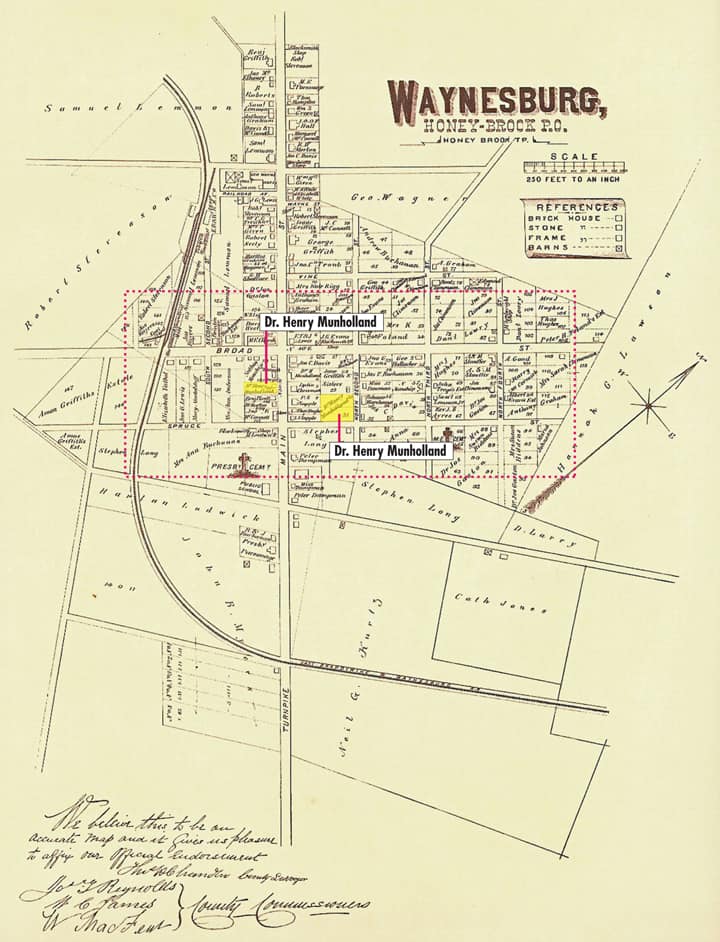
Map of Waynesburg, Honey Brook Township, Chester County, Pennsylvania showing two locations for Dr. Henry Munholland – U.S., Indexed County Land Ownership Maps, 1883
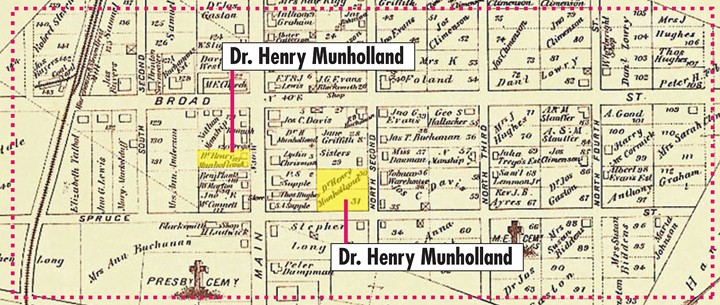
Detail of map of Waynesburg, Honey Brook Township above. Two locations (Main Street & Spruce Street) are marked for Dr. Henry Munholland in 1883. I suspect one was the father and one was the son or one location was there they practiced while the other location was where they made their bitters. – U.S., Indexed County Land Ownership Maps, 1883
There was another Waynesburg in western Pennsylvania. The freight was being routed to the wrong stations. Hence, the name was changed from Waynesburg to Honey Brook.
Representative Timeline Events:
about 1808: birth, Henry Munholland in Pennsylvania, father and mothers birthplace, Ireland, U.S. 1860 Federal Census
1836: married 1836, Anna F. Lauer (1817-88)
1836: Dr. Henry Munholland, buyer, Deed for Honey Brook in Salisbury, Lancaster County, Chester County Deeds
1843: birth (of son) to Henry Sr. and Anna, Henry Munholland in Pennsylvania
1848: Trial for Mal-practice in Pennsylvania – Dr. Henry Munholland (see further below) – Boston Medical and Surgical Journal
1849: On leaving the academy, Mr. Williams (Colonel William C. Williams of Noble County, Indiana) began life on his own resources, by teaching school in Delaware, Maryland, and Pennsylvania, until the fall of 1849, when he entered the study of medicine with * Doctor James Munholland, of Waynesburg, Chester County, Pennsylvania, one of the most successful physicians in the county. – A Biographical History of Eminent and Self-made Men of the State of Indiana, 1880 *PRG: Strange, I believe this should say ‘Doctor Henry Munholland’.
1862: Henry P. Munholland, Honey Brook, Chester, Pa, Medical Glass Section, 1862-63, Trustees, Officers and Students of the University of Pennsylvania, 1863
1862: Oliver Munholland, Private Company D, 1862, The History of Chester County, by Futhey and Cope (1881)
1880: Henry Mulholland, Allopathic Physician, Living at Honey Brook, Chester, Pennsylvania, age 73, wife Annie, U.S. Federal Census
1880: Henry Mulholland, Doctor, Living at Honey Brook, Chester, Pennsylvania, age 37, wife Saloam, U.S. Federal Census
1883: Map (above) showing two locations for Dr. Henry Munholland, Waynesburg, Honey Brook Township, Chester County, Pennsylvania
1890: died, Dr. Henry Munholland (senior), April 10, 1890, 79 years, Honey Brook Presbyterian Cemetery, Chester County
1911: died, Dr. Henry Parker Munholland (junior), 28 April
HISTORY OF THE TOWN OF HONEY BROOK
In 1815, the village of Waynesburg was formed after a schoolmaster by the name of Stinson purchased a lot or common byway of speculation. He had the lot surveyed into town lots and made a lottery. Those holding lots along Horseshoe Pike took possession and promptly paid for their tickets. The back lots took a longer time to sell.
One of the largest problems for the development of the village was water. The village lies on a ridge between the headwaters of the east and west branches of the Brandywine Creek. Wells had to be put down at considerable expense.
The year 1884 saw a change to the village. The railroad from Philadelphia-Downingtown-Lancaster was completed and ran along the south side of Horseshoe Pike. The railroad caused a problem for the village. There was another Waynesburg in western Pennsylvania. The freight was being routed to the wrong stations. Hence, the name was changed from Waynesburg to Honey Brook. This name is from the word Nantmeal which means “sweet stream.”
As the town grew, a petition was circulated in 1891 for the town to be incorporated into a borough. Almost every homeowner signed. With the incorporation into a borough, the main problems to overcome were: street lighting, sidewalks, and several years later water.
The Borough accepted public water in September 1896. At that time, it was a gravity water system requiring little work. Electric streetlights were installed after much discussion in 1915. Before that, gas lamps were used to light the streets.
Over the years, boardwalks were replaced by bricks, then concrete. There are still two brick sidewalks in the Borough. Horseshoe Pike, formerly Main Street, has the only fully paved sidewalks in the Borough.
When the Borough was incorporated, the census was around 700. In 2,000, the census had doubled. The population of the township is now around 5,000 people. [from Honey Brook Township]
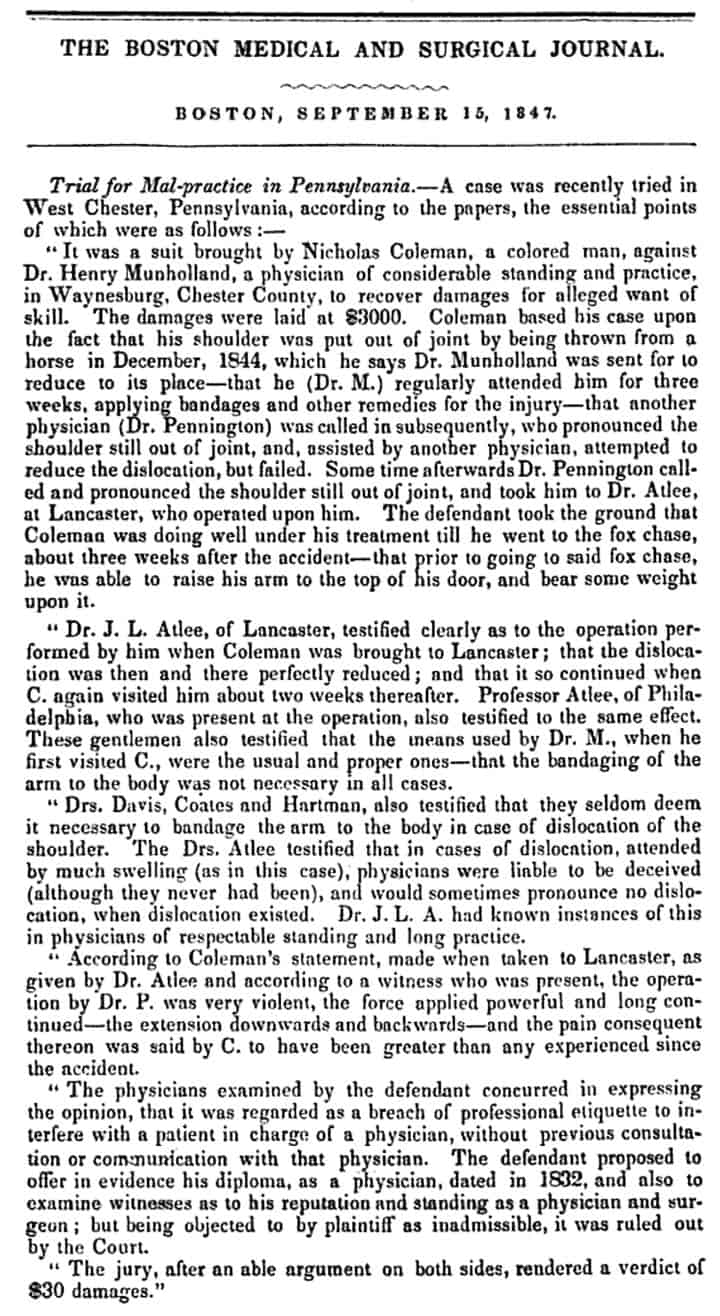
Trial for Mal-practice in Pennsylvania – Dr. Henry Munholland – Boston Medical and Surgical Journal, 1848

